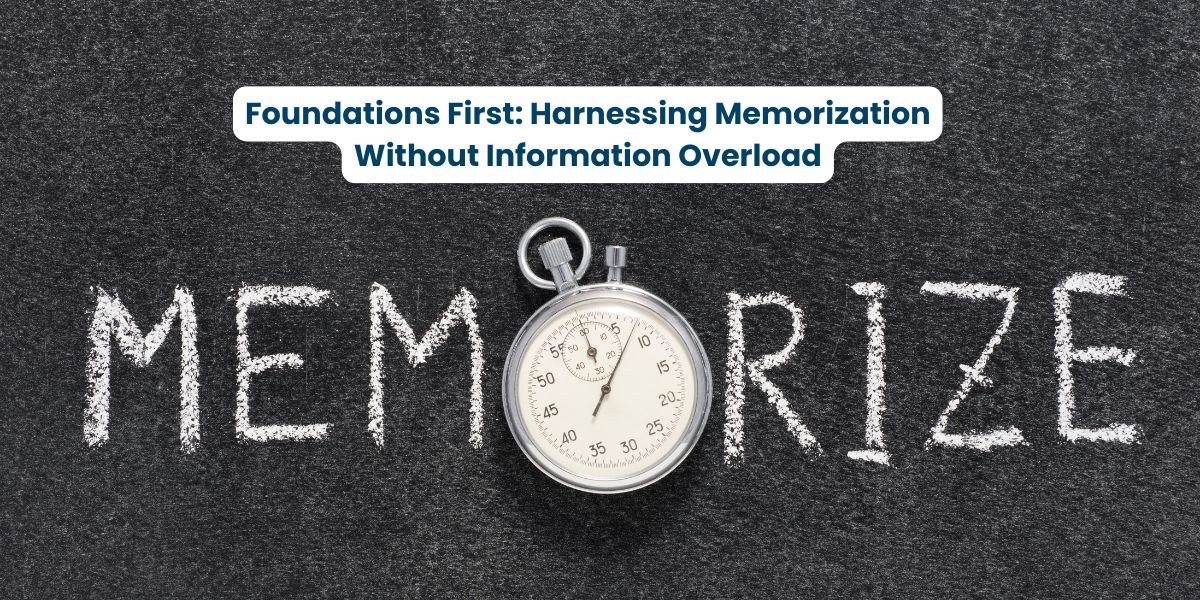
Foundations First: Harnessing Memorization Without Information Overload
Foundations First: Harnessing Memorization Without Information Overload
By Sridevi Srinivasan
Recently, I observed children confidently reciting the names of flowers, scientists, temples, and cities using flashcards. I was completely upset when I saw the children reciting mathematical symbols like alpha, beta, and gamma at just six years old. But the parents’ reaction worried me even more. They were awestruck—proud to see their children reciting the most complex terms with ease.
While the performance was impressive, it made me wonder—does this kind of learning truly benefit the child?
This question led me to reflect deeply on the role of memorization in the learning process.
🧠 The Power of Memorization in Learning
While exploring this topic, one quote stood out:
“Knowledge must precede creativity.” — E.D. Hirsch Jr.
And it’s absolutely true.
- We can’t create unless we can apply.
- We can’t apply unless we understand.
- We can’t understand unless we know.
- And we can’t know unless we can remember.
If you’re familiar with Bloom’s Taxonomy, this will sound familiar. The hierarchy goes:
🔹 Remember
🔹 Understand
🔹 Apply
🔹 Analyze
🔹 Evaluate
🔹 Create
Everything begins with remembering—which means memorization is the foundation.
🔁 Repetition Builds Recall
Repeated recall strengthens neural connections in the brain. It makes future learning faster and deeper. But rote learning doesn’t have to be dull. When integrated with:
- Games
- Visuals
- Storytelling
- Real-life connections
…memorization becomes meaningful and fun.
However, it’s crucial to remember that memorization should be the starting point, not the destination.
✖️ The Multiplication Example
Take multiplication:
A child memorizes:
- 6 × 4 = 24
- 8 × 5 = 40
- 7 × 6 = 42
But what happens if the child:
- Can’t explain that 7 × 6 means 7 groups of 6?
- Struggles with word problems like:
“There are 7 rows of chairs with 6 chairs in each. How many chairs?” - Gets stuck when asked to break it down or visualize?
That’s where understanding needs to enter.
💡 From Memory to Meaning
Imagine the same child:
- Visualizes 7 × 6 as an array or area model
- Uses real-world examples
- Applies flexible strategies like:
(7 × 5) + (7 × 1) = 35 + 7 = 42
Suddenly, the numbers come alive. Now they’re not just reciting, they’re thinking.
Provide pebbles, paper cups, or draw arrays—let them build, touch, and explore—and learning becomes tangible.
🌱 Memorization Is the Foundation—But Only the Start
So, is rote learning bad?
No. Rote learning without understanding is limited.
But memorization + understanding is a powerful combo.
It fuels:
- Critical thinking
- Problem-solving
- Creativity
Memorization isn’t the enemy. It’s a steppingstone to mastery.
🎯 Too Much, Too Soon?
You may now ask:
Is it helpful to make children memorize so many symbols, colors, names, etc., using flashcards?
The answer lies in balance.
Yes, recall and repetition are important. But:
- The content must be age appropriate.
- The child must have time to assimilate what they learn.
- Overloading facts without meaning leads to stress, not success.
Watching kids reel off hundreds of words may look impressive, but it can lead to disinterest or even resentment toward learning over time.
🧩 Conclusion: Make Learning Joyful
Learning becomes effective when we kindle curiosity.
Curiosity thrives when learning is joyful.
And joyful learning comes from activities, exploration, and meaningful engagement.
Yes, memorization is the starting point. But let’s not overwhelm children. Let’s support them in understanding what they’re learning—and why.
💬 Curious to know more?
There’s one skill that supercharges the journey from memory to mastery.
Can you guess what it is?
Share your thoughts—we’ll explore it in the next blog!



